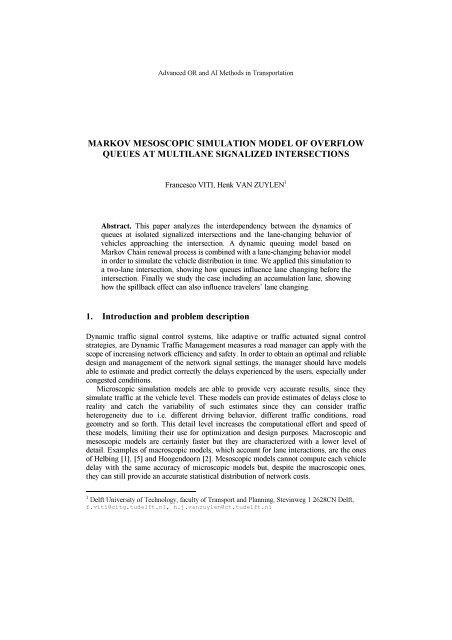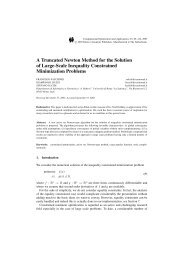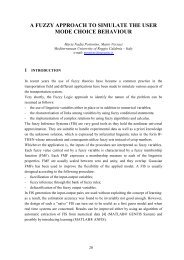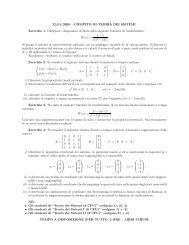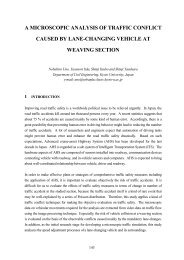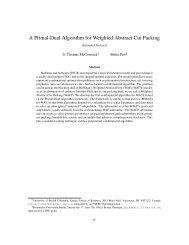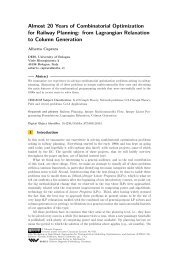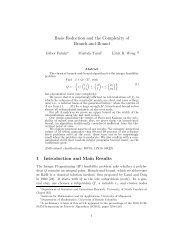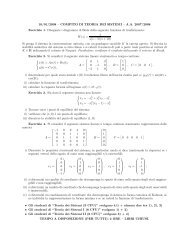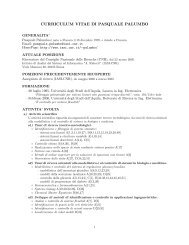MARKOV MESOSCOPIC SIMULATION MODEL OF OVERFLOW ...
MARKOV MESOSCOPIC SIMULATION MODEL OF OVERFLOW ...
MARKOV MESOSCOPIC SIMULATION MODEL OF OVERFLOW ...
Create successful ePaper yourself
Turn your PDF publications into a flip-book with our unique Google optimized e-Paper software.
Advanced OR and AI Methods in Transportation<br />
<strong>MARKOV</strong> <strong>MESOSCOPIC</strong> <strong>SIMULATION</strong> <strong>MODEL</strong> <strong>OF</strong> <strong>OVERFLOW</strong><br />
QUEUES AT MULTILANE SIGNALIZED INTERSECTIONS<br />
Francesco VITI, Henk VAN ZUYLEN 1<br />
Abstract. This paper analyzes the interdependency between the dynamics of<br />
queues at isolated signalized intersections and the lane-changing behavior of<br />
vehicles approaching the intersection. A dynamic queuing model based on<br />
Markov Chain renewal process is combined with a lane-changing behavior model<br />
in order to simulate the vehicle distribution in time. We applied this simulation to<br />
a two-lane intersection, showing how queues influence lane changing before the<br />
intersection. Finally we study the case including an accumulation lane, showing<br />
how the spillback effect can also influence travelers’ lane changing.<br />
1. Introduction and problem description<br />
Dynamic traffic signal control systems, like adaptive or traffic actuated signal control<br />
strategies, are Dynamic Traffic Management measures a road manager can apply with the<br />
scope of increasing network efficiency and safety. In order to obtain an optimal and reliable<br />
design and management of the network signal settings, the manager should have models<br />
able to estimate and predict correctly the delays experienced by the users, especially under<br />
congested conditions.<br />
Microscopic simulation models are able to provide very accurate results, since they<br />
simulate traffic at the vehicle level. These models can provide estimates of delays close to<br />
reality and catch the variability of such estimates since they can consider traffic<br />
heterogeneity due to i.e. different driving behavior, different traffic conditions, road<br />
geometry and so forth. This detail level increases the computational effort and speed of<br />
these models, limiting their use for optimization and design purposes. Macroscopic and<br />
mesoscopic models are certainly faster but they are characterized with a lower level of<br />
detail. Examples of macroscopic models, which account for lane interactions, are the ones<br />
of Helbing [1], [5] and Hoogendoorn [2]. Mesoscopic models cannot compute each vehicle<br />
delay with the same accuracy of microscopic models but, despite the macroscopic ones,<br />
they can still provide an accurate statistical distribution of network costs.<br />
1 Delft University of Technology, faculty of Transport and Planning, Stevinweg 1 2628CN Delft,<br />
f.viti@citg.tudelft.nl, h.j.vanzuylen@ct.tudelft.nl
476 F. Viti, H. van Zuylen<br />
In past research ([6-8]) we applied a mesoscopic model, the Markov Chain renewal<br />
process, to analyze the dynamics of overflow queues at signalized intersections, which<br />
contribute to delay propagation in time and also to its uncertainty. A macroscopic analytical<br />
model has been derived for single lane intersections, which mimics accurately the results of<br />
the Markov model for variable demand and control settings. Scope of the paper is to extend<br />
the study to multilane intersections. Renewal process has been already applied to<br />
investigate lane changing at urban unsignalised intersections [3] but no specific interaction<br />
between queue dynamics and lane changing has been investigated so far.<br />
Allowed lane change section<br />
Accumulation lane<br />
Figure 1. Sketch of a two-lane one-way section with accumulation lane<br />
for right turning vehicles<br />
Figure 1 shows an example of multilane intersection with an accumulation lane<br />
dedicated to right turning vehicles. The flow distribution among lanes is in general not<br />
uniform and one lane may have a higher number of arrivals than the others within a certain<br />
period. Let us suppose that the users have enough time to look at the queue lengths at the<br />
approaching intersection and decide to change lane to reach the shortest one among the<br />
adjacent lanes. In this case the distribution of arrivals at intersection can be such that the<br />
average queues are nearly the same value. The possibility to change lane is limited by the<br />
chance not to have a long enough gap between the cars driving along the adjacent lane to<br />
operate the maneuver. Another factor that may influence lane changing behavior and arrival<br />
distributions at the intersection is an eventual presence of an accumulation lane for turning<br />
vehicles. If the accumulation lane is not efficiently designed, spillback can be frequently<br />
observed, producing hindrance also to the flows at the adjacent lane.<br />
Section 2 describes the mesoscopic queuing simulation model and the lane changing<br />
behavior model. In section 3 we formulate the lane-changing model while results of the<br />
model under different demand conditions, reduced chance of changing lane and the effect<br />
of spillback of an accumulation lane are presented and analyzed in section 4. Finally,<br />
conclusions are drawn in section 5.<br />
2. Multilane Markov mesoscopic simulation model description<br />
In this paper we evaluate the impact of queue dynamics at signalized intersections to lane<br />
selection approaching the intersection by using a probabilistic approach. To do so, we<br />
implement a stochastic lane-changing model to a previously developed queuing model<br />
based on a renewal process [7].
Markov mesoscopic simulation model of overflow queues… 477<br />
An intersection designed to serve a large number of vehicles can have a complex<br />
structure. In order to reduce conflicts between different streams accumulation lanes for<br />
some directional flows can be designed, as shown in figure 1. Some intersections may even<br />
require more than one lane dedicated to some directional flows.<br />
As introduced in the previous section, a multilane does not work in general exactly like<br />
if all lanes were separated. In fact, when only one lane is available, the FIFO condition<br />
strictly holds for all travelers, since overtaking is not possible. In this condition the<br />
randomness of the queue is simply generated by the randomness of the arrivals and the<br />
departures at each cycle. In a multilane intersection the arrivals are not in general equal at<br />
each lane, and consequently the users may experience different delays. In order to reduce as<br />
much as possible the risk to spend extra time at the intersections, the users may try to move<br />
to the lane, which has the least number of vehicles to be served at that moment. This<br />
operation is not always possible, because of the presence of other vehicles on the target<br />
lane. We assume that the demand at a certain distance from the intersection is split<br />
randomly on all available lanes and that we are able in some way to characterize both the<br />
probability distribution of the demand and of the splitting rates. Moreover, vehicles arrive<br />
at the intersection randomly and the headway between cars can be also characterized by a<br />
probability distribution.<br />
The queuing process depends on the randomness of arrivals and departures, but the<br />
demand at the next cycles can be influenced by the queue distribution itself because of lane<br />
changing behavior. We assume here that the user increases his intention to change lane the<br />
larger the difference between the queue at his lane and the target one is. Since queue length<br />
is characterized by a probability distribution also this intention can be described with a<br />
probability distribution. Once this probability is computed we have to compute whether it is<br />
possible for the vehicle to do the maneuver. We apply the Bayesian updating rule to<br />
compute this chance, thus we compute the conditional probability that a vehicle changes his<br />
current lane. This probability is simply computed by the product of the two probabilities,<br />
since we assume they are independent stochastic variables.<br />
3. Model formulation<br />
3.1. Markov chain model of queues<br />
To compute the queue dynamics and the probability of a queue to be observed at a certain<br />
time t we apply the Markov Chain process already used in previous research [6–8].<br />
The method provides a way of computing the probability of a queue to occur on a<br />
certain cycle based on the probability computed at the previous cycle given the<br />
distributions of the arrivals and the departures during the cycle phase. A description of the<br />
method and the simulation results for a single lane intersection can be found in [4] and [6].<br />
The advantage of this method is that it is able to compute the dynamics of the expectation<br />
value of the queue and its probability distribution under very general assumptions without<br />
the computation effort required by microscopic simulation models.
478 F. Viti, H. van Zuylen<br />
3.2. Lane changing behavior model<br />
Let i be a lane of a road section just before a signalized intersection and j be an adjacent<br />
lane. Let us suppose that the user has time to evaluate the queue lengths in front and<br />
(eventually) change lane. Suppose also to know the number of vehicles served within a<br />
cycle C by knowing the saturation flow S i and the length of the green phase g.<br />
Knowing the average and distribution of the split rates we can compute for each lane the<br />
flow distribution d i by using the relationship di = αi<br />
⋅ d , where d is the flow approaching<br />
the intersection and α i is the percentage of vehicles entering from lane i.<br />
Let q ( t), q ( t ) be the queues at the two lanes at time t and let us suppose to know the<br />
i<br />
j<br />
queue distribution at the starting of the simulation for each lane q<br />
i0 ( t ) . We assume that the<br />
travelers’ probability of “intention” to change lane is:<br />
⎧⎪ Pi →j ( t) = g( qi ( t) − qj ( t)) if qi ( t) − qj<br />
( t) > 0<br />
⎨<br />
(1)<br />
⎪⎩ Pi →j<br />
( t) = 0 otherwise<br />
We assume the probability as a known function g, which increases and gets closer to 1<br />
the larger the difference between queues is. Inversely, if the queue at the traversing lane is<br />
smaller there is no reason to consider a possible lane change to the adjacent lane. A user<br />
can change lane only if there is enough gap for the maneuver. Known the number of<br />
arrivals we can deduce the distribution of distances among cars and consequently the<br />
probability of having enough space to change lane. For example if the arrival distribution is<br />
poissonian the headway distribution can be approximated as exponential.<br />
The chance of having a sufficient gap to change lane is then equal to the probability<br />
P ( l ≥ l ) that the distance between cars observed is higher than a predefined thresholdl .<br />
j<br />
Once computed these probabilities the number of vehicles di → j<br />
changing from lane i to<br />
lane j will be given by:<br />
d ( t) = d ⋅ P ( t) ⋅ P ( l ≥ l )<br />
(2)<br />
i→j i i→j j<br />
The total number of arrivals f<br />
i<br />
at lane i will then be:<br />
f = d − d ( t) + d ( t)<br />
(3)<br />
i i i→j j→i<br />
Known the distribution of departures s<br />
i<br />
the queue at the following cycle can be<br />
computed like we did for single lane isolated intersections:<br />
q ( t + 1) = q ( t)<br />
+ s − f<br />
(4)<br />
i i i i<br />
Note that in the single lane problem the arrivals were independent on the present queue,<br />
and the transition matrix was invariant with time, while in this case it is time-dependent.<br />
3.3. Lane changing model with spillback at the accumulation lane<br />
Suppose now that there is an accumulation lane aside of one of the straight through lanes.<br />
For simplicity we assume that the vehicles arriving at the intersection and that have to turn
Markov mesoscopic simulation model of overflow queues… 479<br />
are already at the closest lane before entering in the accumulation lane, thus no lane<br />
changing to reach the accumulation lane is considered.<br />
We can assume the green time for this extra lane different from the straight through<br />
lanes, g acc . Under these assumptions the queue at the accumulation lane is computed exactly<br />
as a single lane intersection using the standard single lane Markov Chain.<br />
Let β i be the fraction of the total demand d representing turning flows and let L k be the<br />
maximum number of vehicles, which can be placed in the accumulation lane without<br />
creating a spillback effect. Due to randomness of arrivals there is a non-zero chance of<br />
having spillback. The probability that spillback occurs can be computed with the Markov<br />
model. In this condition the adjacent lane will be influenced by this phenomenon. We<br />
suppose here that if the length of the adjacent lane queue is smaller than the accumulation<br />
lane queue the user will consider for his lane changing behavior the latter. Thus, all<br />
equations above do not change apart equation (2) that becomes:<br />
⎧P→<br />
( t) = g(max( q , q ) − q ) if q ( t) > q and max( q , q ) > q<br />
⎪<br />
⎨Pi → j<br />
( t) = g( qi ( t) − q<br />
j<br />
( t)) if qi ( t) − q<br />
j<br />
( t) > 0 and qacc ( t)<br />
< qspillback<br />
⎪<br />
⎩Pi<br />
→ j<br />
( t) = 0 otherwise<br />
i j i acc j acc spillback i acc j<br />
(5)<br />
4. Presentation of simulation results<br />
We apply the above models to the test scenario depicted in figure 1. We are especially<br />
interested in knowing to what extent the dynamics of the queue can influence lane-changing<br />
behavior in slight undersaturated conditions, where queue dynamics do not have linear<br />
behavior. First simulation considers only 2 straight through lanes, with 60% of vehicles on<br />
the right lane. Second simulation adds up an accumulation lane placed aside the right<br />
through lane.<br />
Saturation flow is set to 1800 vehicle per hour, while cycle and green time and set<br />
respectively to 60 and 24 seconds, while green time for the accumulation lane is set to 10<br />
seconds and maximum number of vehicles allowed is set to 5 vehicles.<br />
Figure 2 shows, on the top pictures, the evolution of the average and the standard<br />
deviation of the queues at the straight through lanes, while the bottom pictures show the<br />
lane changing behavior expressed by the evolution of split rates. Left figures show the<br />
condition when the degree of saturation of the signal is set to 0,95. Because of lane<br />
changing possibility both lanes reduce their average queue with respect to the single lane<br />
case shown in [6]. Standard deviation improves accordingly. Due to gap acceptance<br />
limitation, the two lanes are still not having the same demand (left figures). When demand<br />
increases, lane changing also increases, since intention to change lane increases and flows<br />
tend to be equally distributed (center). The chance to have spillback on the right lane due to<br />
a right accumulation lane increases the demand on the left lane further (right).<br />
The proposed lane changing model results depend on the choice of the parameters of the<br />
lane-changing aspiration model, the gap acceptance and the dynamic queuing model and<br />
the calibration of these parameters is needed for its practical use. It is rather unlikely that<br />
sufficient real data under the considered assumptions could be collected [6].
480 F. Viti, H. van Zuylen<br />
Figure 2: queue average and st. deviation evolution and split rates arrivals at the<br />
intersection for x=0,95 (left figures), x=0.98 without accumulation lane (center) and<br />
with accumulation lane (right).<br />
5. Conclusions<br />
In this paper we investigated the effect of queue dynamics on lane changing behavior of<br />
users approaching an isolated signalized intersection, uncovering the interplay between the<br />
two characteristics. We used a mesoscopic simulation technique to model the queue<br />
dynamics and its variability in time and a probabilistic method to simulate lane preference<br />
and gap acceptance of the users. We show in the paper that queuing models should consider<br />
travelers’ lane changing due to unequal queues at the intersection combined with a gap<br />
acceptance model to accurately estimate the delays that a traveler may incur.<br />
Moreover we showed that extra delay could be observed if an accumulation lane is<br />
badly designed, since the spillback effect can influence the dynamics of queues at other<br />
lanes.<br />
The model can be generalized to all queuing phenomena of the type M/M/n.<br />
References<br />
[1] Helbing, D.. Modelling multilane traffic flow with queuing effects. Physica A,<br />
242:175-194, 1997.<br />
[2] Hoogendoorn S.P. Multiclass continuum modelling of multilane traffic flow. PhD<br />
thesis. Delft University of Technology, the Netherlands, 1996.<br />
[3] Ngoduy D., Hoogendoorn S.P., Van Lint J.W.C. Modeling traffic flow operation in<br />
multilane and multiclass urban networks. In Proceedings of the 84 th TRB Meeting,<br />
January 9-13, 2005, Washington D.C.
Markov mesoscopic simulation model of overflow queues… 481<br />
[4] Olszewski P. Modeling of Queue Probability Distribution at Traffic Signals. Transp.<br />
and Traffic Theory, ed M.Koshi, Elsevier, Amsterdam, pp. 569-588, 1990.<br />
[5] Shvetsov V., Helbing D. Macroscopic dynamics of multilane traffic. Physical review<br />
E, 59, 6328-6339, 1998.<br />
[6] Van Zuylen H.J. and Viti F. Uncertainty and the Dynamics of Queues at Signalized<br />
Intersections. In Proceedings of the CTS-IFAC conference 2003, 6-8 August, Tokyo.<br />
Elsevier, Amsterdam, 2003.<br />
[7] Viti F. and Van Zuylen H.J. Modeling queues at signalized intersections.<br />
Transportation Research Record 1883, 68-77. National Research Council, Washington<br />
D.C., December 2004.<br />
[8] Viti F. and Van Zuylen H.J. Modeling overflow queues on urban signalized<br />
intersections. In Proceedings of the 10 th World Conference of Transport Research, 7-8<br />
July 2004, Istanbul, Turkey, 2004.


